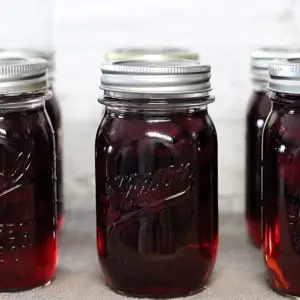Welcome to the world of pickled beets, where humble roots are transformed into tangy, vibrant delights that add a burst of flavor to any dish. If you’ve ever savored the zesty tang of a pickled beet and wondered how to recreate that magic at home, you’re in the right place. In this blog, we’ll embark on a culinary adventure together, demystifying the art of pickling and equipping you with the knowledge and skills to create your own batch of perfectly pickled beets.

This post may contain affiliate links. Please read my disclosure policy.
Jump to RecipeHistory of Pickled Beets
European settlers brought their pickling traditions to the New World, where beets found a new home in the fertile soils of North America. Pickled beets became a fixture on colonial tables, valued not only for their taste but also for their long shelf life. Recipes for pickled beets were passed down through generations, becoming a cherished part of American culinary heritage.
In recent years, there has been a resurgence of interest in pickling and preserving foods as people rediscover the joys of homemade and artisanal products. Pickled beets, with their bold flavor and vibrant color, have captured the imagination of chefs and home cooks alike. Creative variations and innovative recipes have elevated pickled beets from humble pantry staple to gourmet delicacy, earning them a place on menus in upscale restaurants and trendy eateries.
Health and Wellness
Beyond their delectable flavor, pickled beets offer a plethora of health benefits. Rich in vitamins, minerals, and antioxidants, these ruby-red wonders pack a nutritious punch. Pickled beets can support heart health, aid digestion, and contribute to overall well-being.
What Is Pickling?
Pickling is a method of food preservation that involves submerging food items, such as fruits, vegetables, or meats, in a solution of vinegar, salt, sugar, and spices. This process creates an acidic environment that inhibits the growth of bacteria, molds, and yeast, thus extending the shelf life of the food and preserving its freshness and flavor.
There are two main methods of pickling: fermentation and vinegar pickling. Fermentation involves allowing naturally occurring bacteria to convert sugars into lactic acid, which acidifies the environment and preserves the food. This method is commonly used for pickling foods such as cucumbers (to make pickles), cabbage (to make sauerkraut), and kimchi.
Vinegar pickling, on the other hand, involves submerging the food in a solution of vinegar and spices, which creates an acidic environment that prevents the growth of harmful microorganisms. This method is often used for pickling a wide variety of fruits and vegetables, including beets, onions, peppers, and eggs.
The pickling process not only preserves the food but also imparts it with a unique flavor profile characterized by tanginess, sweetness, and a blend of aromatic spices. Pickled foods can be enjoyed on their own as a snack or condiment, or incorporated into a wide range of dishes to add depth and complexity to the flavor. Whether you’re pickling cucumbers for homemade pickles or experimenting with pickling exotic fruits and vegetables, the art of pickling offers endless opportunities for culinary creativity and exploration.
Ingredients Needed To Make Pickled Beets
Pickled beets require a few simple ingredients:
- Beets
- White vinegar
- Sugar
- Water
My pickling brine recipe is also super simple: 1 cup each of vinegar, water, and sugar. This makes the perfect balance between tangy and sweet.
How To Make Pickled Beets
This recipe is easy to adjust for your personal needs. You can make a single jar for your refrigerator or make a large batch for preserving. I have not listed the amount of beets required for this reason. Refrigerated pickled beets will last up to 3 months. Preserved beets have a shelf life up to 2 year. Store opened preserved beets in the refrigerator.
The Process:
- Trim tops of beets, but do not cut the top completely off. This will keep the beets from “bleeding” out all their color while cooking.
- Scrub beets under cold water and place into a large stock pot. Cover with water and bring to a boil.
- Cook until the beets easily pierce with a fork. Drain beets into a colander or remove them to a large bowl. Allow to cool completely.
- TIP: When preserving a large batch, I do these first three steps the day before and allow the beets to cool overnight.
- Wear gloves to prevent your hands from staining. Remove the skins and cut into slices or chunks into clean, sterile canning jars. The skins will slip off quite easily. Pack beets into jars leaving a 1-inch headspace.
- In a separate large sauce pot, combine equal parts white vinegar, sugar, and water (depending upon how many jars you are making). Bring mixture to a boil and ensure all the sugar is dissolved.
- Pour brine over beets leaving a 1/2-inch headspace. The beets should be completely submerged.
- For refrigerator beets, simply place a lid on the jars and keep in the refrigerator.
- For preserving, place a canning lid and ring onto jars. Place jars on a rack in a water-bath canning pot. Be sure jars are completely submerged under water by at least 2 inches.
- Process jars for 15 minutes after coming to a rolling boil. Allow the jars to cool completely, remove rings, wipe jars and store on shelf.
Serving Suggestions
Everyone loves pickled eggs and beets! Simply hard boil eggs, peel, and submerge them under the beet brine. Let them sit in the refrigerator overnight. If you’ve never had a pickled egg soaked in homemade pickled beets, then you are in for a treat! The color is unbelievable and the taste is even better!

Pickled beets are often served alongside Easter or Christmas ham, and are a hit at any picnic or party.
As we conclude our exploration of the tangy world of pickled beets, I invite you to savor the flavors, embrace the history, and celebrate the culinary versatility of this beloved vegetable. Whether you’re preserving a taste of tradition or charting new culinary territory, pickled beets are sure to add a vibrant burst of flavor to your table. So pick up your jars and get ready to pickle, because the journey is just beginning. Happy pickling!

Perfectly Simple Pickled Beets
Equipment
- 1 Stock pot
- 1 Large sauce pot
- 1 Water bath canner If preserving your beets
- Glass jar(s) and lid(s) Canning lids/bands, jar lifter, funnel if preserving
- Measuring cups
Ingredients
- 1 Bunch red beets More if preserving
- 1 cup White vinegar
- 1 cup Sugar
- 1 cup Water
Instructions
- Trim tops of beets, but do not cut the top completely off. This will keep the beets from "bleeding" out all their color while cooking.
- Scrub beets under cold water and place into a large stock pot. Cover with water and bring to a boil.
- Cook until the beets easily pierce with a fork. Drain beets into a colander or remove them to a large bowl. Allow to cool completely.
- Wear gloves to prevent your hands from staining. Remove the skins and cut into slices or chunks into clean, sterile canning jars. The skins will slip off quite easily. Pack beets into jars leaving a 1-inch headspace.
- In a separate large sauce pot, combine equal parts white vinegar, sugar, and water (depending upon how many jars you are making). Bring mixture to a boil and ensure all the sugar is dissolved.
- Pour brine over beets leaving a 1/2-inch headspace. The beets should be completely submerged.
- For refrigerator beets, simply place a lid on the jars and keep in the refrigerator.
- For preserving, place a canning lid and ring onto jars. Place jars on a rack in a water-bath canning pot. Be sure jars are completely submerged under water by at least 2 inches.
- Process jars for 15 minutes after coming to a rolling boil. Allow the jars to cool completely, remove rings, wipe jars and store on shelf.


I grew up with pickled beets! I am so happy to see this recipe. It makes my heart sing!